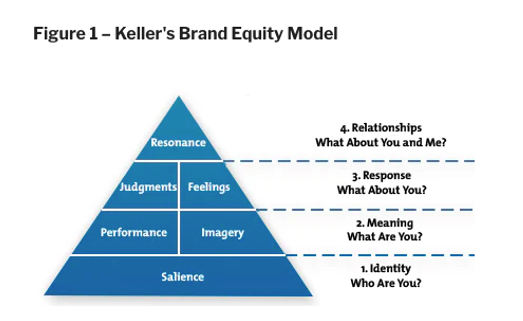Debates within the marketing communications industry are easily one of the most fascinating things to observe. Not only are they frequent, which in my view, demonstrates a high rate of engagement with various subject matter but they are also a function of the dynamic world within which we live.
One debate that I have followed closely in recent years, is what I call the long-short dichotomy.
This refers to the delicate balancing act that we as marketers, must constantly perform to ensure marketing effectiveness.
When it comes to marketing effectiveness, there are few papers that are as instructive as Les Binet and Peter Field’s ‘The long and the short of it’.
In The long and the short of it Binet and Fields stress the importance of balancing both the long and the short-term imperatives when developing and implementing a marketing strategy.
Typically, “the long” refers to brand building. This is usually measured using the Keller Brand Equity Model.

This model, in pyramid form, begins with brand salience at the bottom and ends with brand resonance at the top.
It tracks the extent to which a consumer goes from being able to recognise a brand (salience) based on its brand identity (logo, slogan, colours, fonts etc), to the feelings consumers associate with the brand. And ultimately, the extent to which consumers see themselves as being part of the brand (resonance).
All brands want to achieve a level of brand resonance with their target audience. This is usually an indication of how loyal your consumers are and contributes positively towards other key business metrics like market share and revenue growth.
This is a long-term and concerted effort and is undergirded by emotive storytelling. As it takes time for brands to take up and hold that kind of mental availability in the minds of the consumer.
Lasting impact
Binet and Fields assert this when they say, “Emotionally-driven campaigns have a lasting impact on brand equity. Establishing an emotional connection with consumers contributes significantly to long-term success.
“Consistency in messaging builds mental availability. Brands that are mentally available are more likely to be chosen by consumers when making purchasing decisions.”
Conversely, when we speak of the “the short”, this refers to marketing tactics that help deliver short-term results, such as sales promotions and performance or digital marketing.
With performance marketing, the focus is on converting consumers while they’re on their path to purchase.
So, if you’re looking for a new running shoe and you search for the term “running shoe store near me” and the top result is a sponsored ad from Sportsman’s Warehouse with an Adidas running shoe worth R999, then you’re a victim of performance marketing.
Depending on where you are on the sales funnel, you’ll hopefully click on the ad, taking you to their e-commerce site, prompting you to add to cart and eventually clear cart.
You’ve become a sale
And just like that, you’ve become a sale. By becoming a paying customer, you’ve helped the company achieve one of two (sometimes both) of the company’s objectives: sales and market share growth.
This kind of conversion usually happens quickly depending on the kind of product you’re looking for. For example, it typically takes a car buyer about three months to move from “looking for a car” to “ready and able to buy”.
However, it might only take a week for the same buyer to go from “looking for a running shoe” to “ready and able to buy”.
This long-short dialectic has prompted many debates amongst marketers regarding which is more important. Do we spend 70% of the budget on brand building and the remaining 30% on performance marketing or vice versa?
This question is particularly important in the context of the environment within which most marketers work.
Building brand equity
One that is often governed by board and Exco packs, a perennial juniorisation of the marketing and communications function and dwindling budgets.
As marketers, it’s a famous secret that we must do twice as much to convince our CA(SA) colleagues that spending money on long-term marketing efforts will help us in the short-term as well.
What’s often sexier is the quarterly and annual sales growth from short-term promotional activity. That stuff is tangible and is backed up by numbers like customer acquisition costs (CAC), attribution and clickthrough rates.
While stuff like brand equity and brand resonance sound like esoteric nice-to-haves that marketers use to try and get more money.
This is contrary to how the marketing effectiveness gurus see it, as Binet and Fields state, “Success extends beyond immediate sales. Long-term success involves building brand equity, customer loyalty, and a positive brand perception.”
Both approaches
In The long and the short of it, Binet and Fields also argue: “The best campaigns are a blend of short-term sales activation and long-term brand building. Both are essential for sustained business success.”
We need both approaches to achieve marketing success.
Without long-term brand building, we can’t achieve the short-term sales results because we won’t have the brand equity required to convert potential customers.
In addition, without the short-term performance, we won’t have the money to do the brand building work. It doesn’t come cheap.
Although we acknowledge that these two variables are co-dependent, it’s also important to caveat that while brand building can help us achieve short-term performance marketing goals (sales), performance marketing alone cannot achieve brand building goals (brand equity).
I think we can thus accept, that the long is indeed the short of it.
 Khanyisa Melwa is a marketing communications professional whose 9 years of experience has seen him straddle roles in brand marketing, digital audience measurement, event management and activations and everything in between. He now plies his trade at one of South Africa’s largest pension funds (by AUM), where he serves as a communications specialist. When he’s not stuck in Teams meetings, he shares marketing insights gleaned from industry reports on his Substack newsletter: https://khanyisa.substack.com/
Khanyisa Melwa is a marketing communications professional whose 9 years of experience has seen him straddle roles in brand marketing, digital audience measurement, event management and activations and everything in between. He now plies his trade at one of South Africa’s largest pension funds (by AUM), where he serves as a communications specialist. When he’s not stuck in Teams meetings, he shares marketing insights gleaned from industry reports on his Substack newsletter: https://khanyisa.substack.com/














